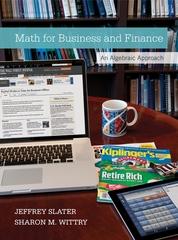Question
CASE STUDY 2 The case method is based on a philosophy of professional education which associates knowledge directly with action (Boehrer, 1995). This philosophy rejects
CASE STUDY 2
The case method is based on a philosophy of professional education which associates knowledge directly with action (Boehrer, 1995). This philosophy rejects the doctrine that students should first learn passively, and then, having learned, should apply knowledge. Instead, the case method is based on the principle that real education consists of the cumulative and unending acquisition, combination and reordering of learning experiences. There are two fundamental principles underpinning the case method. First, the best-learned lessons are the ones that students teach themselves, through their own struggles. Second, many of the most useful kinds of understanding and judgement cannot be taught but must be learned through practical experience. When instructors assign problems or papers in a course, they are motivated by a similar concern: by working through the problem set on their own or writing the paper, students reach a deeper understanding of the concepts and ideas than they would have if they only read the text or listened passively to lectures. Case method teaching extends this principle to make preparing for class and the class session itself an active learning experience for students. By using complex real-world problems as the focus, it challenges students to learn skills that will be appropriate to deal with the practical problems that they will face as economists, civil servants or private managers. Teaching through the case method allows educators to address specific pedagogical issues and to develop higher-order skills in students. Velenchik (1995) highlights four pedagogical issues addressed by the case method: Motivation to learn theory. In general, undergraduate economics courses tend to treat applications as secondary to the exposition of theory. In our teaching we often use examples to illustrate the application of particular theoretical concepts. However, we tend to use the example to reinforce the theory, having taught the theory first, rather than thinking of the theory as a set of tools for answering the question posed by the application. The focus, therefore, is on the theory itself, and the application is often perceived as incidental. When students do not understand the purpose of theory, the process of learning becomes more dry and difficult than it needs to be, and they often fail to grasp the tools they need. In the case method, the problem that the students are challenged to solve takes centre stage. They soon realise that they do not have the tools and they start looking for the tools. They want to learn theory. Application of theory. The ultimate goal of economics education is to enable students to apply economic reasoning to particular policy issues. The focus is generally as much on the process of policy analysis as on the specific area of policy. One method for illustrating the process is through examples related to lectures. However, this is problematic. The example is often preceded by theory, so that students think of the application as a use of the theory, rather than seeing the theory as a tool for dealing with the issues raised by the application. Examples are commonly selected because they are good illustrations of particular theoretical concepts, but they do little to help students learn which theories are appropriate for which kinds of policy problem. On the other hand, the case method requires the student to identify the theory that best addresses the economic problem under investigation. Use of evidence. Empirical analysis, guided by theoretical concepts and analytical tools, is central to many economics modules. Students are often required to develop an ability to use quantitative. Answer the following questions ASAP. Do not answer if not familiar with the unit.
1. Which of the subsequent is/are accompanying with _________the financial sector of India and controlled by________ the Replacement Row of India (RBI)_________?
2. What prepares price floorboards cruel___________?
3. Why is the unemployment rate low in India statistically?
a] Unemployment is calculated only from the age group of 15 years to 59 years.
b] Unemployment survives only when an individual cannot find a job.
c] People are not interested in working outside the domestic area.
Choose the correct option.
4. What does the bowed-out shape __________of the production possibilities__________ curve illustrate________?
5. What is the main monetary_________ problem confronted by__________ the the social order____________?
6. What prepares "Private enterprise" discuss to_________?
7. The goal of a uncontaminated marketplace economy__________ is to meet the desire of ______ .
8. What organizes the law of________ request______ mean______?
9. Which of the subsequent is an specimen of an agronomic price sustenance database?
Step by Step Solution
There are 3 Steps involved in it
Step: 1

Get Instant Access to Expert-Tailored Solutions
See step-by-step solutions with expert insights and AI powered tools for academic success
Step: 2

Step: 3

Ace Your Homework with AI
Get the answers you need in no time with our AI-driven, step-by-step assistance
Get Started


